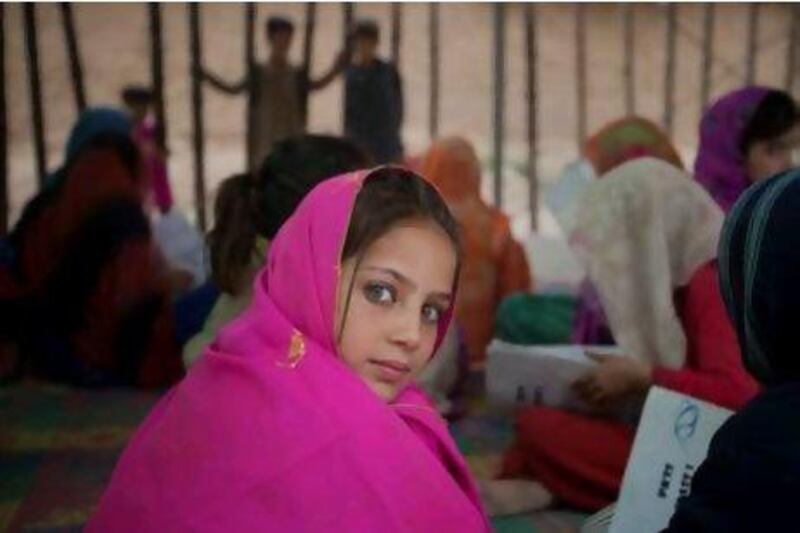Amid international outrage over the Taliban shooting of Malala Yousafzai, a unique school system in Pakistan is teaching not just girls from conservative families, but some of the country's poorest children. And where the children go, the schools follow.
As their neighbours leave their homes for work, or slope off to the local tea-stall for breakfast, the children of a tiny Pakistani village on the outskirts of Islamabad gather on a patch of sunlit ground.
They are pupils in the Pehli Kiran School System, a non-profit network for youngsters whose families are too poor to afford even the most basic education.
Many are refugees from Afghanistan, or from families displaced by military operations in Pakistan or by the devastating floods that hit the country in 2010 and last year.
Parents say this school in Golra Sharif, on the edge of Pakistan's affluent capital, is changing lives.
"Before this, children were running around without any hope and no one to guide them," says Akbar Khan, 55, whose son and daughter attend the school. "They had no future."
Pehli Kiran, run by the Jamshed Akhtar Qureshi Education Trust, began field operations in 1996.
They are the brainchild of a prominent human-rights activist, Tahira Abdullah, and her family, many of whom volunteer at the schools.
A network of volunteers, teachers and donors, many of whom have other jobs or are still studying, make education here possible.
The trust relies heavily on donations to keep the schools running, paying teachers a nominal salary.
Dotted around temporary settlements on the edge of Islamabad, known as katchi abadis, eight schools teach about 1,200 children.
Many of these settlements are illegal collections of shacks made from mud, straw, branches and plastic sheeting. The schools are as temporary as the villages, the residents of which face a constant fear that city authorities may ask them to move.
Thin posts hold up corrugated roofing. The walls are colourful murals or fabric sheets, hung out each morning and carefully packed away when lessons are over.
The children sit on straw mats and only a few of the schools have a proper floor.
Their temporary feel though, according to Ms Abdullah, is one reason behind their success.
"When the people move, the schools move," she says. "They don't know when they will be asked to move on, so we have made the schools like this deliberately - we follow the communities when they move so the children stay in the schools."
Pakistan spends less than 1.5 per cent of its gross domestic product on education, and many schools charge fees. The official literacy rate is a little more than 50 per cent.
As the Pehli Kiran schools opened up education to children who had never been to a lesson before, they became more popular and demand grew.
Classes concentrate on core subjects such as Urdu, English, maths and science, but aim to include vocational classes.
As more girls began attending, Pehli Kiran expanded the curriculum to include embroidery and stitching, aiming to give them a way to gain economic independence.
"It gives girls here the chance to learn a skill," Ms Abdullah says. "They can sell their embroidery, or learn to stitch clothes. It gives them that chance to become a little more independent and make their own living."
She is particularly proud that girls make up about half the number of students in some classes, and says having a safe environment close to their homes has encouraged even conservative families to enrol their daughters. It is a development that would not please the Taliban, who shot the Swat valley schoolgirl Malala Yousafzai this month for daring to defy their objections to the education of girls.
The schools charge just 10 Pakistani rupees a month (38 fils), compared with government-run schools that can charge higher rates.
Members of the parents' association try to encourage other families to allow their children to attend the schools.
"Parents in the committee talk to those that are still not sending their children to the school, and try to convince them," Mr Khan says.
Other parents working to support the school say their neighbours were initially nervous when the schools were first established.
"When the school first started and volunteers came here, people would not be very welcoming," explains Khan Muhammad, who plans to send his one-year-old son to the school when he is old enough. "I didn't go to school and don't know how to read and write," he admits. "There are so many things I cannot do, so many doors are closed to me."
Pehli Kiran's volunteers and teachers have striven to make the schools as friendly and as welcoming as possible, despite the absence of conventional schoolrooms.
Lessons begin at 8am, when the pupils group together by class on large mats spread carefully below the wide roofs, and continue until 4pm. The children, many painfully shy, come alive during lessons, eagerly copying from whiteboards.
"We have 265 students enrolled at this school. It is increasing all the time, which is great," says Ghazanfar Ali, head teacher at the eighth Pehli Kiran school.
The value the Pehli Kiran system has brought to these tiny settlements is clear from the way parents living in the villages talk about the value they give to education.
"I know the life I have lived, what I have had to go through," says Mr Muhammed, whose life in Pakistan as an Afghan refugee has been fraught with financial difficulties and uncertainty.
"I don't ever want that for my son, and the only way he is going to have a fighting chance is if he goes to school."





